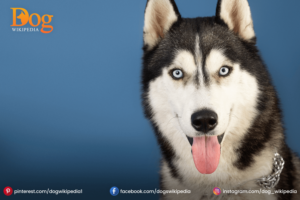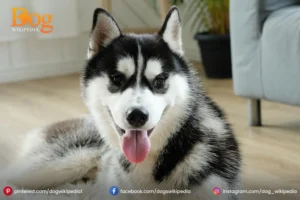Akita Husky Mix: Introduction
A fascinating cross between the noble Akita and the lively Siberian husky is the Akita Husky mix, also frequently referred to as an Akita Husky hybrid. Owing to the diverse lineage of its parent breeds, this hybrid often possesses a robust, athletic build with a thick double coat that exhibits variations in color and pattern. The loyalty and intellect of Akita Husky mixes are well known. They often get quite close to their families, which makes them loyal and affectionate friends.
1- Physical attributes of Akita Husky Mix
They have a medium-to-long coat with a coarse, dense texture that is double-coated and heavily sheds twice a year. They have coats in a variety of hues, including cream, black, gray, brown, and white in combination. Their almond-shaped, brown to blue, piercing eyes are expressive and some have the appearance of having two eyes.
Their wedge-shaped head, which has a black nose, firm jaw, and a flat forehead, is framed by tall, pointed triangle ears. Their athletic, muscular frame is characterized by a flat topline, well-sprung ribs, and a broad chest that ends in a bushy tail. With large pads and webbed feet, their oval-shaped paws are built for endurance and agility.
2- Temperament of Akita Husky Mix
Blending the protective and devoted temperament of the Akita with the gregarious and extroverted traits of the Siberian Husky, the Akita Husky mix is a devoted and wise dog. They need persistent and patient teaching since, although clever and trainable, they occasionally exhibit independence and stubbornness. They are energetic and loving with their family, and they love being around and being noticed.
But they might take some time to become used to new people and can be suspicious of strangers. To help them acquire self-assurance and a composed attitude, early socialization is essential .Because of the Husky effect, they have an active and daring personality that requires mental and physical stimulation on a frequent basis to keep them from becoming bored and engaging in destructive conduct.
3- Personality of Akita Husky Mix

The loyal and protective traits of the Akita are usually inherited by this cross, combined with the lively and amiable disposition of the Siberian Sea. These canines make both loving friends and vigilant watchdogs since they frequently exhibit a close relationship with their people.
Some have a more autonomous and quiet nature, while others are gregarious and playful. Their personalities might differ greatly from one another. All things considered, they do best under the guidance of a firm but caring hand and love being in energetic settings where they can let their fun and adventurous sides show.
4- Akita Husky mix’s health considerations
Hereditary Health Problems
Bloat or gastric torsion
– Patellar luxation (dislocation of the kneecap)
– Heart issues
-Connection to Siberian Husk
– Corneal dystrophy
-Hypertrophic cardiomyopathy (heart illness)
-Progressive retinal atrophy
Common Health Concerns
– Weight control is essential for obesity
– Dental issues: routine dental visits are crucial
-.Skin Conditions: dermatitis, allergies, and hot areas
-Regular ear cleaning is required to prevent ear infections.
-Joint care and management of arthritis
Health Testing
-A hip assessment
– The Eye Examination
5- Needs of Akita Husky Mix
Using a shedding rack slicker brush every day is essential during the spring and fall when there is a lot of shedding. Their coat stays clean and silky if they take a bath every two to three months using a gentle wash and hydrating conditioner.
While weekly ear cleaning with a mild solution helps avoid infections, clipping nails every four to six weeks minimizes overgrowth and discomfort. Tartar accumulation is avoided and healthy gums are promoted by brushing your teeth twice a day.
6- Training requirements of Akita Husky Mix

Create positive behavior and avoid undesirable behaviors, the Akita Husky mix needs early socialization, fundamental obedience training, and housebreaking. This breed responds best to training techniques that use positive reinforcement, such as clicker training and reward-based programs. They can be stubborn and independent at times, but consistency, patience, and gentle supervision are necessary.
Eight to ten weeks is a good time to start training, with short sessions (10 to 15 minutes) that concentrate on learning the fundamentals of sit, stay, come, and leash walking. In order to successfully eliminate housebreaking, a schedule and consistency must be established, along with positive reinforcement. Housetraining and reducing separation anxiety are two benefits of crate training.
Required Training
-Early socialization being around people, places, and noises.
-Simple obedience walking on, sitting, staying, and coming.
7- Specific needs of Akita Husky Mix
To Address the physical, emotional, and social needs of the Akita Husky mix, an all-encompassing strategy is needed. (Evaluations of the hips and elbows, vision tests, and dental care (frequent brushing, check-ups) are examples of specific health needs.
8- Living requirements for an Akita Husky Mix
To address the physical, emotional, and social needs of the Akita Husky mix, an all-encompassing strategy is needed. Evaluation of the hips and elbows, vision tests, and dental care (frequent brushing, check-ups) are examples of specific health needs. The grooming requirements include weekly ear cleanings, frequent nail trimmings, bathing.
9- Exercise and activity needs of an Akita Husky Mix
For this high-energy breed to stay entertained and avoid destructive behavior, they require 1-2 hours of exercise per day. Hiking, jogging, swimming, agility and obedience training, playing in dog parks, fetch, and scent work are all appropriate hobbies. Exercise regimens should be modified, nevertheless, based on factors like age, health, and level of fitness. Adolescents (4-6 months) require moderate exercise, whereas puppies (8–12 weeks) need short, mild exercise (10–15 minutes).
10- Ownership cost of Akita Husky Mix
The initial outlay of $680–$2,790 and monthly costs of $150–$415 make up the ownership costs of an Akita Husky mix. In contrast, the long-term costs of surgery and dental care can vary from $3,000 to $6,000. Annual veterinarian care and immunizations cost $320 to $750. The entire anticipated cost is between $15,000 and $30,000.for the dog’s 10–14 year . 
Conclusions
An intellectual, active, and devoted owner is necessary for the loyal, intelligent, and energetic Akita-Husky mix. This breed, which has a 10- to 14-year lifetime, blends the protection and strength of the Akita with the energy and spirit of playfulness of the Husky. They require regular training and two to three hours of daily activity since they are attention-seekers and mentally stimulated seekers. They need frequent maintenance because of their heavy shedding thick coat. Regular veterinary check-ups are crucial because of health concerns including as allergies, hip dysplasia, and vision problems.

